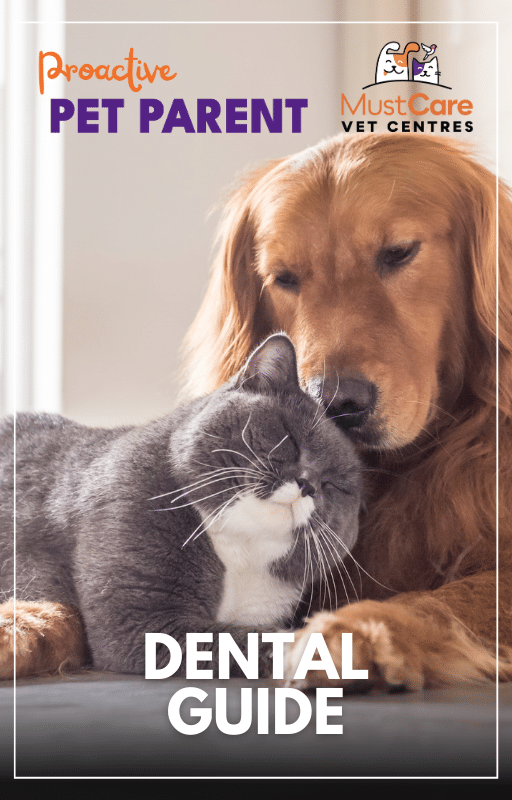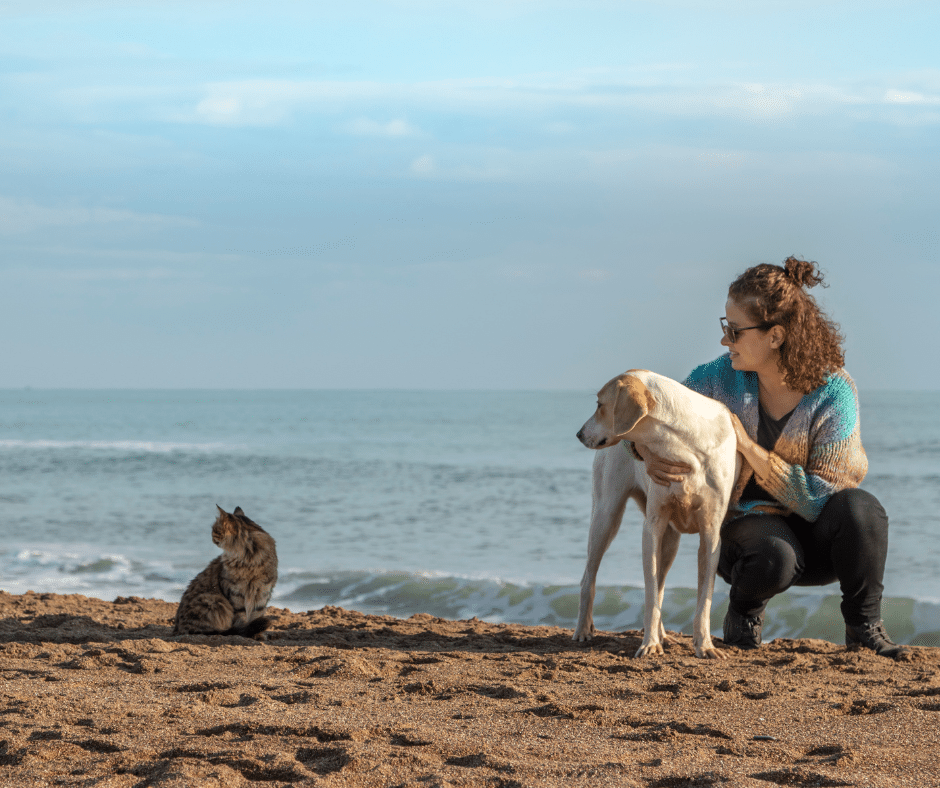Share This Blog With Other Pet Parents!
Shielding Pets: Preventing Sunburn and UV Damage
As the season of summer comes to a close, pet owners plan outdoor adventures with their furry companions. However, with temperatures still feeling like summer, this may provide a false sense of security about a lesser-known danger: sunburn and UV damage in pets. Just like humans, cats and dogs are susceptible to the harmful effects of ultraviolet radiation. But don’t worry, this article provides essential strategies to shield your pets from too much sunshine. From identifying signs of sunburn to implementing preventive measures, we explore the crucial steps every pet owner must take to ensure their furry friends enjoy the sun safely.
What you’ll learn from this blog:

For all you need to know, download our
FREE Dental Guide
This blog is part of our Proactive Pet Parent series! This is just the beginning… To see more blogs, click here! Better yet, sign-up to our newsletter to receive these directly to your inbox each month.
Sign-up To The Proactive Pet Parent Newsletter
Understanding Sunburn and UV Damage In Pets
Sunburn in pets occurs much like it does in humans, although with subtle differences. When exposed to the sun for prolonged periods, pets, particularly those with lighter fur or skin, can experience varying degrees of sunburn and UV damage. Unlike humans, pets lack the ability to apply sunscreen or seek shade when needed, making them more susceptible to sun-related injuries. The sun’s UV rays penetrate the skin, causing damage to the underlying cells and tissues. Over time, this damage can lead to painful burns, skin cancer, and other serious health issues in pets. Certain breeds, such as hairless cats and dogs and cats and dogs with thin or light coloured fur, are at higher risk of sunburn and UV damage. By understanding the mechanisms of sunburn and UV damage in pets, pet owners can take proactive steps to protect their pets from harm.
Identifying At-Risk Pets
Certain factors increase a pet’s susceptibility to sunburn and UV damage. Understanding these risk factors is very important for pet owners so they can take appropriate precautions.
- Pets with light-coloured fur or skin, such as white cats or dogs with pink noses, are more prone to sunburn due to reduced melanin production.
- Additionally, breeds with thin or sparse fur, such as hairless cats or breeds with short coats, have less natural protection against UV rays.
- Age also plays a role, as younger animals and elderly pets may have thinner skin, making them more vulnerable to sunburn.
- Furthermore, pets with pre-existing skin conditions or compromised immune systems may be at higher risk of sun damage.
It’s essential for pet owners to be mindful of these factors and take proactive steps to protect their pets from harmful UV rays.
Preventative Measures
Taking preventive measures is key to safeguarding pets from sunburn and UV damage. Here are some approaches you can take:
- One of the most effective ways to protect pets is by limiting their exposure to direct sunlight, especially during peak hours when UV rays are strongest.
- Create shaded areas in the yard or provide shelter for pets when spending time outdoors.
- Applying pet-safe sunscreen to exposed areas of the skin, such as the nose, ears, and belly, can provide an extra layer of protection.
- When selecting sunscreen for pets, it’s essential to choose a formula specifically designed for animals, as human sunscreen can contain ingredients that are harmful to pets if ingested.
- Invest in protective clothing for their pets, such as lightweight shirts or hats designed to block UV rays.
- Maintaining proper hydration is also crucial, as sun exposure can increase the risk of dehydration in pets.
- Lastly, remember to check the pavement temperature before walking your pet. Place the back of your hand on the concrete for seven seconds, if it’s too hot for you to keep your hand there, then it’s too hot for your four pawed friend.
By implementing these preventive measures, pet owners can significantly reduce the risk of sunburn and UV damage in their canine and feline friends, allowing them to enjoy the outdoors safely.
Recognising the Signs
It’s important for pet owners to be able to recognise the signs of sunburn and sun damage in their cats and dogs. Symptoms of sun damage in pets may include:
- Red or inflamed skin, particularly in areas with thin fur or exposed skin
- Blisters, sores, or lesions may also develop, indicating severe sunburn and potential skin damage
- Hair loss, peeling skin, or changes in skin texture are additional signs that your pet may have suffered from prolonged sun exposure
- In some cases, pets may exhibit signs of discomfort or pain, such as excessive scratching or licking of affected areas.
It’s crucial for pet owners to monitor their pets closely, especially after spending time outdoors in the sun. By recognising these symptoms early on, pet owners can take prompt action to alleviate their pet’s discomfort and prevent further damage. If you notice any concerning symptoms or changes in your pet’s skin condition, it’s important to consult with a veterinarian for proper evaluation and treatment. MustCare Vets is here to help.
Treatment and Management
If a pet experiences sunburn or sun damage, prompt treatment and management are essential to promote healing and prevent complications. Depending on the severity of the sunburn, treatment may include soothing topical ointments or creams to alleviate pain and inflammation. Veterinarians may also prescribe medications or oral supplements to support skin healing and reduce discomfort. In cases of severe sunburn or blistering, pets may require specialised veterinary care, including wound cleaning and bandaging to prevent infection.
Pet owners should follow their veterinarian’s recommendations closely and monitor their pet’s condition closely for any signs of improvement or worsening. With timely treatment and management, pets can recover from sunburn and sun damage and resume their normal activities safely. By prioritising their pet’s health and well-being, pet owners can ensure their furry companions receive the care and attention they need to be happy and healthy in the sunshine.
Lifestyle Adjustments
Making lifestyle adjustments is important for pet owners to minimise their pets’ sun exposure and reduce the risk of sunburn and UV damage. One effective adjustment is to create a pet-friendly environment indoors, especially during peak sun hours when UV rays are strongest. Providing plenty of shaded areas and comfortable resting spots indoors encourages pets to seek shelter from the sun.
Additionally, scheduling outdoor activities during early morning or late afternoon when the sun’s intensity is lower can help mitigate sun exposure. When spending time outdoors, pet owners should consider investing in protective clothing or accessories for their pets, such as lightweight shirts or hats designed to block UV rays. These items provide an extra layer of protection, particularly for pets with light-coloured fur or exposed skin.
Finally, incorporating indoor enrichment activities, such as puzzle toys or interactive games, keeps pets mentally stimulated and reduces their reliance on outdoor activities during peak sun hours. By making these lifestyle adjustments, pet owners can create a safe and comfortable environment for their pets, allowing them to enjoy the outdoors responsibly.

